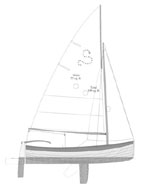Small
Daysailer
Dinghies can be divided into three general types: performance one-designs like the Laser and Tasar; trainers like the Hunter 170 and the T15.5; and traditional dinghies based on historical types like the Beetle Cat and Small. I'm big on emphasizing the style aspect of sailing. And if you're not going to race and you want a boat that conjures up images of small-boat sailing when you were a kid, the traditional types are the ticket.
The biggest disadvantage to the traditional types is that they can be heavy and slow. But Dias has combined the looks of the traditional "British day boat" with modern construction techniques to create a dinghy with enough performance to satisfy a seasoned dinghy sailor while providing the panache of a classic type.
This dinghy is available in finished form with a molded fiberglass lapstrake hull or you can assemble it yourself from pre-cut pieces of trim and a bare molded hull. You can also build a Small in timber using glue lap-and-strip-composite construction. William Clements of North Billerica, Massachusetts, is the builder.
The hull shape shows shapely ends with a hint of hollow in the entry and enough hollow in the stern sections to give the dinghy a nice, almost heart-shaped transom, which is accented by a gently curved, solid-rod traveler that goes from gunwale to gunwale.
Centerboard and rudder are carefully designed to optimize performance, and the rudder pivots for trailering. The centerboard is off center so it doesn't interrupt the keelson. A wide and flat caprail makes sitting on the rail to hike easy on the buns.
The rig is called a "Solent Gunter" and is sort of a hybrid between a Marconi-headed sloop rig and a gaff rig. For upwind performance you would want your gaff peaked as high as possible to increase the length of the leading edge of the mainsail. The advantage over a Marconi rig is that you can break the rig down into shorter spar lengths for stowage and you get to say "gunter."
I'd prefer to see longer battens, and the jib sheeting angle is quite wide with the jib sheeting to what appears to be an eye bolt on the caprail. It might be nice to sheet the jib closer, although it might not make much difference with the gunter main anyway. Everything has to be in sync.
This dinghy would make a nice rowboat. Two sets of oarlocks are drawn with the forward rower sitting on the mast partners thwart. For sailing, the seats are about 10 inches below the sheer, which will make you feel like you are "in" rather than "on" the boat. This is also a nice feature when sailing with small kids.
On a nice day, with the sun shining and the wind blowing a steady 12 knots, you can have fun sailing just about anything. Why not do it in style?

Comments